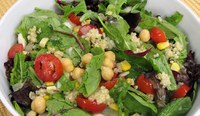Prairie Fare: Have You Tried Quinoa?
(Click an image below to view a high-resolution image that can be downloaded)
By Julie Garden-Robinson, Food and Nutrition Specialist
NDSU Extension Service
Whenever I see the word “quinoa” (pronounced keen-wa), I think of my younger daughter’s reaction to it when I brought some home the first time. She was curious about a food with a name that began with the letter “q.” She began studying the package.
I had done my homework before my purchase, so I was eager to share what I had learned. I explained that quinoa is an edible seed that originated near Peru and Bolivia. The ancient Incas of Peru referred to quinoa as “chisaya mama,” or the “mother grain.” In early times, quinoa was roasted and ground into flour, and the flour was used to make bread.
Quinoa is a good source of protein and essential amino acids, which are the protein building blocks our bodies use to develop and repair tissues. The United Nations deemed 2013 the International Year of Quinoa because of the role it can play in nutrition.
I don’t think my daughter was particularly impressed by the nutrition lesson or my attempts at sharing food history. I think she was wondering what strange concoction I was planning to introduce at the dinner table.
However, she liked the name of this interesting ingredient and she added some martial arts moves. She kicked a foot and arm out as she yelled “keen-wa!” and danced around the kitchen. I tried to avoid her flying feet.
I wish I would have known at the time that, from a plant science standpoint, quinoa is a member of the “goosefoot” group of plants. She really would have had fun choreographing a food by the name of “goosefoot.”
I didn’t tell her quinoa is related to spinach, chard and beets, though. She might have hopped out the door.
In many grocery stores, you will find quinoa in a specialty foods section or near the rice and other grains. Technically, quinoa is considered a “pseudo-cereal” (pseudo means false) because it is cooked and eaten like a grain and has similar nutrition to a grain. After cooking, quinoa resembles short-grain rice or couscous (a durum wheat product).
Quinoa can be used in a variety of recipes, including soups, salads, main dishes, breads and crackers. Besides protein, quinoa provides vitamin E, potassium, iron, magnesium, zinc, and other vitamins and minerals.
Nutrition educators consider quinoa among the “whole grains” on our menus because of its nutritional content. Quinoa’s subtle nutty taste has made it a trend in the restaurant industry during the past several years. In fact, you may have heard quinoa referred to as a “super food” in the popular press.
Be sure to follow the package directions when preparing quinoa. Most varieties are ready to eat in about 15 minutes, similar to white rice. Quinoa has a bitter natural outer coating that serves as a pest deterrent during the growing period. Most quinoa manufacturers remove the coating, but you might want to place the quinoa in a strainer and rinse it before cooking as a final step.
We all should be making at least half of our grain food choices whole grains to promote good health. Whole grains can help protect us against heart disease, cancer and other chronic diseases. However, most people shortchange themselves on their consumption of whole grains.
Here are five tips to add more whole-grain foods to your menu:
- Substitute brown rice or quinoa in place of white rice as the base layer for stir-fried vegetables or as a side dish. To add flavor, use vegetable broth as the liquid.
- Try adding whole grains to mixed dishes. Try whole-grain barley in soups or bulgur wheat in casseroles.
- Use whole-grain cracker crumbs or oatmeal as a meat extender in meatloaf or meatballs.
- Substitute whole-wheat flour for up to half of the white flour in pancakes, muffins or waffles.
- Have a bowl of cooked oatmeal or quinoa with fresh fruit for your morning breakfast.
This delicious salad recipe makes use of some of fall’s vegetable bounty. Try fresh corn sliced off the cob and late-season greens as ingredients. Diced cucumbers also would be a nice addition.
Quinoa Salad
1 c. quinoa, dry (cook according to package directions)
1 1/2 c. onion, chopped
1 (15-ounce) can corn, drained and rinsed (You can substitute 2 c. frozen or fresh, cooked corn)
1 (15-ounce) can chickpeas, drained and rinsed
1 c. cherry tomatoes, sliced
5 ounces Spring Mix salad greens (or your favorite greens)
Salad dressing ingredients
3 Tbsp. red wine vinegar
3 Tbsp. olive oil
2 tsp. cumin
2 tsp. lemon pepper
Prepare quinoa and vegetables as directed. Place all salad ingredients in a large bowl and toss to combine. Mix salad dressing ingredients together. Pour over salad right before serving.
Makes eight servings. Each serving has 230 calories, 8 grams (g) fat, 7 g protein, 34 g carbohydrate, 3 g fiber and 100 milligrams sodium.
(Julie Garden-Robinson, Ph.D., R.D., L.R.D., is a North Dakota State University Extension Service food and nutrition specialist and professor in the Department of Health, Nutrition and Exercise Sciences.)
NDSU Agriculture Communication - Aug. 27, 2015
| Source: | Julie Garden-Robinson, (701) 231-7187, julie.garden-robinson@ndsu.edu |
|---|---|
| Editor: | Ellen Crawford, (701) 231-5391, ellen.crawford@ndsu.edu |



